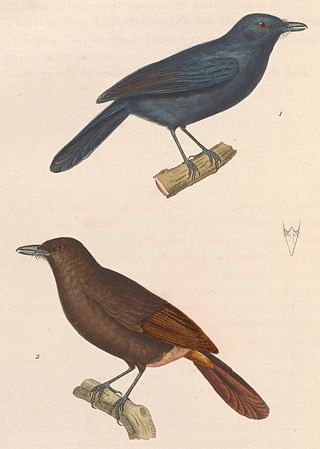
The American dipper, also known as a water ouzel, is a semiaquatic bird species native to western North America.

Streptomyces is the largest genus of Actinomycetota, and the type genus of the family Streptomycetaceae. Over 700 species of Streptomyces bacteria have been described. As with the other Actinomycetota, streptomycetes are gram-positive, and have very large genomes with high GC content. Found predominantly in soil and decaying vegetation, most streptomycetes produce spores, and are noted for their distinct "earthy" odor that results from production of a volatile metabolite, geosmin. Different strains of the same species may colonize very diverse environments.

Glufosinate is a naturally occurring broad-spectrum herbicide produced by several species of Streptomyces soil bacteria. Glufosinate is a non-selective, contact herbicide, with some systemic action. Plants may also metabolize bialaphos and phosalacine, other naturally occurring herbicides, directly into glufosinate. The compound irreversibly inhibits glutamine synthetase, an enzyme necessary for the production of glutamine and for ammonia detoxification, giving it antibacterial, antifungal and herbicidal properties. Application of glufosinate to plants leads to reduced glutamine and elevated ammonia levels in tissues, halting photosynthesis and resulting in plant death.

Streptomycetaceae is a family of the class Actinomycetota, making up the monotypic order Streptomycetales. It includes the important genus Streptomyces. This was the original source of many antibiotics, namely streptomycin, the first antibiotic against tuberculosis.
The yellow-eyed black flycatcher is a small passerine bird of the genus Melaenornis in the flycatcher family Muscicapidae native to the Albertine Rift montane forests.

The slender antbird is an Endangered species of bird in subfamily Thamnophilinae of family Thamnophilidae, the "typical antbirds". It is endemic to Brazil.

The dusky-throated antshrike is a species of bird in subfamily Thamnophilinae of family Thamnophilidae, the "typical antbirds". It is found in Bolivia, Brazil, Colombia, Ecuador, French Guiana, Guyana, Peru, Suriname, and Venezuela.

Thamnomanes is a genus of insectivorous birds in the antbird family, Thamnophilidae. They are restricted to the Neotropics and are important components of forest mixed-species feeding flocks.

Streptomyces griseus is a species of bacteria in the genus Streptomyces commonly found in soil. A few strains have been also reported from deep-sea sediments. It is a Gram-positive bacterium with high GC content. Along with most other streptomycetes, S. griseus strains are well known producers of antibiotics and other such commercially significant secondary metabolites. These strains are known to be producers of 32 different structural types of bioactive compounds. Streptomycin, the first antibiotic ever reported from a bacterium, comes from strains of S. griseus. Recently, the whole genome sequence of one of its strains had been completed.

Streptomyces hygroscopicus is a bacterial species in the genus Streptomyces. It was first described by Hans Laurits Jensen in 1931.

Streptomyces avermitilis is a species of bacteria in the genus Streptomyces. This bacterium was discovered by Satoshi Ōmura in Shizuoka Prefecture, Japan.
Streptomyces abikoensis is a bacterium species from the genus Streptomyces which produces the antibiotic abikoviromycin. Streptomyces abikoensis has been isolated from Abiko in Japan.
Streptomyces albidoflavus is a bacterium species from the genus of Streptomyces which has been isolated from soil from Poland. Streptomyces albidoflavus produces dibutyl phthalate and streptothricins.
Streptomyces cinnamoneus is a bacterium species from the genus of Streptomyces which has been isolated from soil in Japan. Streptomyces cinnamoneus produces duramycin A, duramycin B, duramycin C, carbomycin, cinnomycin and fungichromin.
Streptomyces diastaticus is an alkaliphilic and thermophilic bacterium species from the genus of Streptomyces. Streptomyces diastaticus produces oligomycin A, oligomycin C, rimocidin and the leukotriene-A4 hydrolase-inhibitor 8(S)-amino-2(R)-methyl-7-oxononanoic acid. Streptomyces diastaticus also produces gougerotin and diastaphenazine and the antibiotic ruticin.
Streptomyces hiroshimensis is a bacterium species from the genus of Streptomyces which has been isolated from soil. Streptomyces hiroshimensis produces the red pigment prodigiosin.
Streptomyces microflavus is a bacterium species from the genus of Streptomyces which has been isolated from soil. Streptomyces microflavus produces nemadectin, fattiviracin A1, milbemycin and deoxyuridines. Streptomyces microflavus also produces the ionophore valinomycin. Streptomyces microflavus is also known to cause potato common scab disease in Korea.
Cytochrome P450, family 107, also known as CYP107, is a cytochrome P450 monooxygenase family in bacteria, found to be conserved and highly populated in Streptomyces and Bacillus species. The first gene identified in this family is Cytochrome P450 eryF (CYP107A1) from Saccharopolyspora erythraea. Many enzymes of this family are involved in the synthesis of macrolide antibiotics. The members of this family are widely distributed in Alphaproteobacteria, cyanobacterial, Mycobacterium, Bacillota, and Streptomyces species, which may be due to horizontal gene transfer driven by selection pressure.
Cytochrome P450 family 154 subfamily C member 3 is an actinobacterial Cytochrome P450 enzyme originally from Streptomyces, which catalyzes the 16α-hydroxylation of various steroids.








